by Jason Bodner
April 30, 2024
Pressure cookers have been around since 1679. The theory is that increased pressure raises cooking temperatures more than normal atmospheric pressures. This results in much more efficient cooking. But if the pressure is not safely vented… KABOOM! Rare as it is, they can explode, causing serious harm. However, if the pressure is periodically released in small amounts, everything runs smoothly.
Tax season always feels like a pressure cooker for me. I feel squeezed to gather all those detailed documents, count all the beans, and remember things for multiple businesses and people in my household. It culminates at deadline day, and just like that – the pressure valve is released.
Another big pressure valve in April was the stock market finally selling off. The much-awaited selloff was swift. Spawned by hot inflation likely to make the Fed more hawkish, it felt uncomfortable at the time.
Looked at unemotionally however, markets were very overdue for a normal pullback, which really started closer to April Fool’s Day than Tax Day. The pressure cooker released some healthy steam. If there were no such release and stocks just kept flying higher, inevitably the market would crash and cause much more serious damage… KABOOM! The action we saw was a natural and necessary release of pressure.
But it’s also natural to wonder what comes next, and how long we should expect this leakage to last.
For my longtime readers, you know that I don’t rely on my emotions for investing guidance. They have failed me time and time again. What hasn’t failed me is the cold, hard data. And that’s the lens I look through to see the market for what it really is, at any given time.
First, let’s assess the state of the market and survey where the money is flowing. Then, we will look at some historical context for earnings, seasonality, and a climate similar to today. So… let’s dig in!
First, let’s look at the state of unusual buying by large professional investors, which I call Big Money. The selling that rocked the market for the first two weeks of April has subsided. We are also starting to see some small buying. It’s important to note that the way our data works, this can’t be the same stocks. To get a sell signal, stocks must slice below their roughly 11-week low on huge volume. To get a buy, the price has to surge above an 11-week high with big volume. So, the stocks sold in early April are not the same ones getting bought now. ETFs were also sold in early April, but we are not seeing buying just yet:
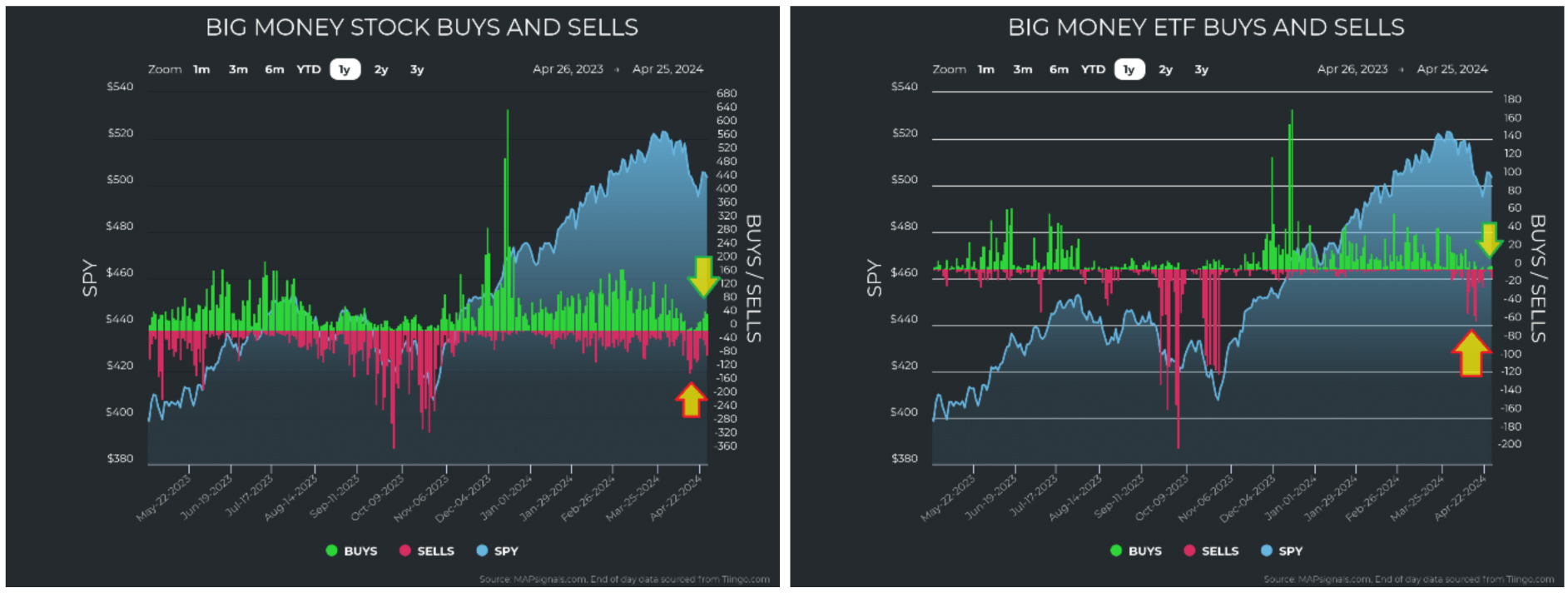
Graphs are for illustrative and discussion purposes only. Please read important disclosures at the end of this commentary.
To track down the money flows, let’s look at the selling of early April compared to this past week. The first two weeks of April saw significant selling (left chart, below, 697 sold stocks). Health Care and Technology accounted for half of the selling. Compare that to the first four days of last week (right chart). We saw far less selling and, in fact, more balanced buying versus selling. Buying however, was in Energy, Financials, Industrials, and Staples. Selling continued, albeit at a slower pace, in Discretionary and Health Care.
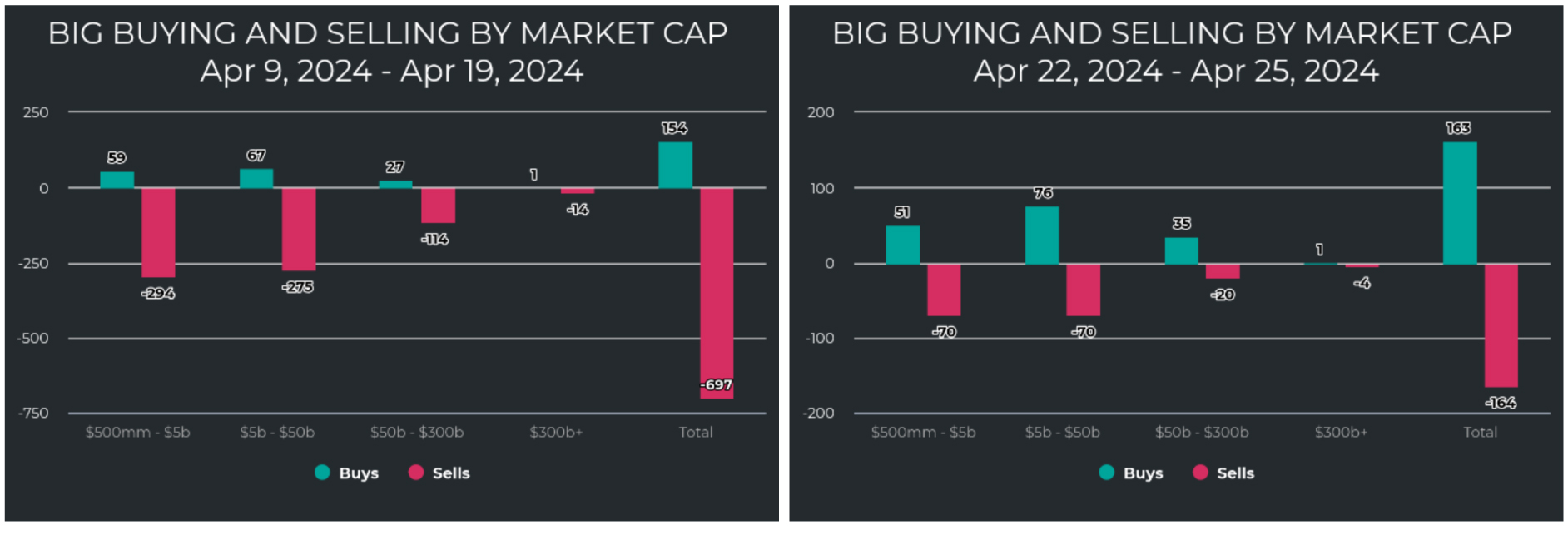
Graphs are for illustrative and discussion purposes only. Please read important disclosures at the end of this commentary.
Tracking the money flows from when the bull market was strongest is a good comparison to now.
Below we see very clear pictures of sector rotation from 2023 year-end to now. Tech and Discretionary were dethroned by Energy and Financials, with Staples also climbing in the ranks:
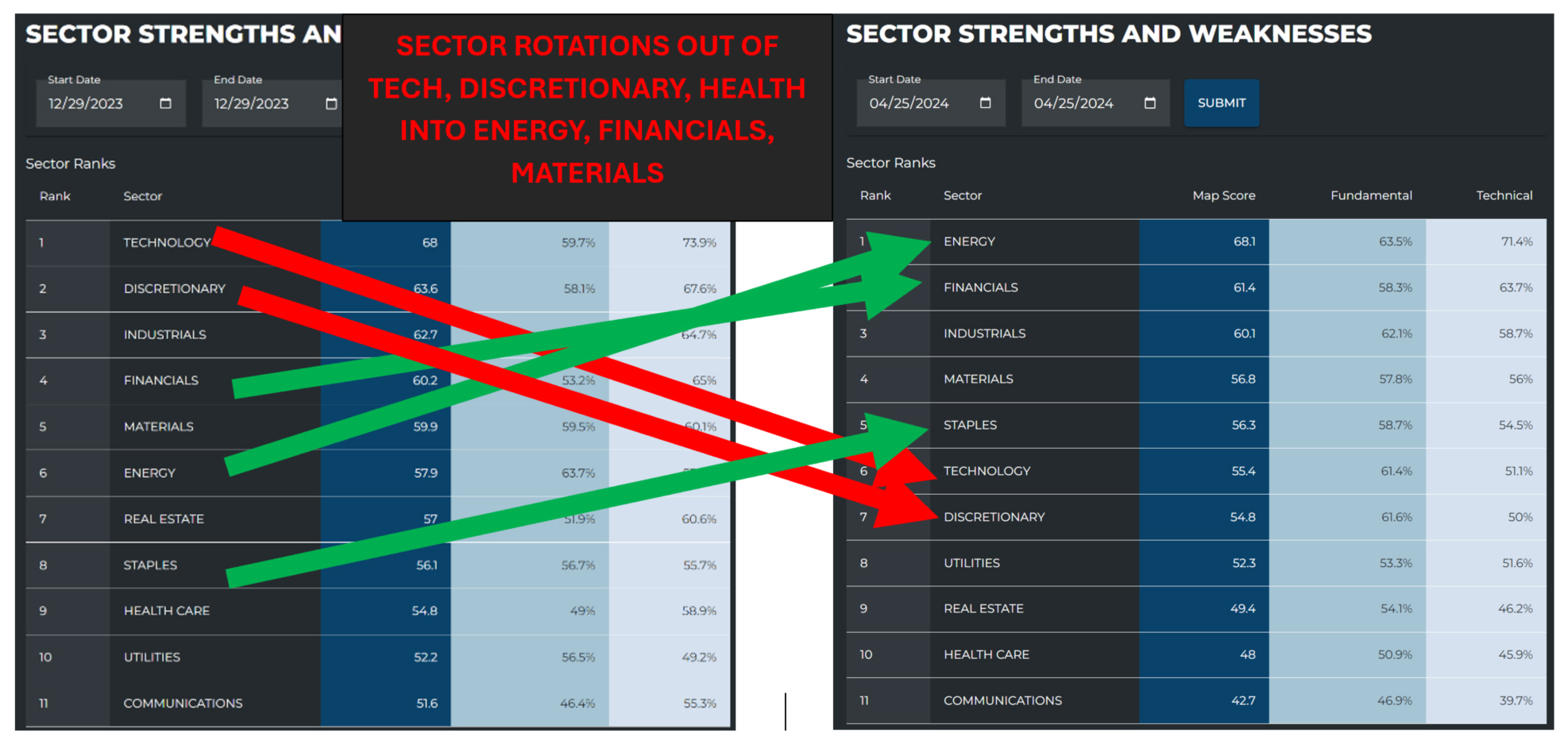
Graphs are for illustrative and discussion purposes only. Please read important disclosures at the end of this commentary.
It always helps to visualize money flows. Here we see individual sectors. Notice the drop-off of buying in most sectors except Energy, Financials, and Utilities. Selling was biggest in Health care. Staples saw some selling but a quick snap back to buying (different stocks within the sector), flipping from early to late April. Tech continues to drag. Bellwether earnings were mixed, with some of the former Magnificent 7 stocks with disappointing guidance after beating in sales and earnings, while others had strong reports.

Graphs are for illustrative and discussion purposes only. Please read important disclosures at the end of this commentary.
Seasonality says volatility is a few weeks early but mostly on schedule. May and June are seasonally less strong than other months. August and September are when we expect the most volatility… that’s for later!
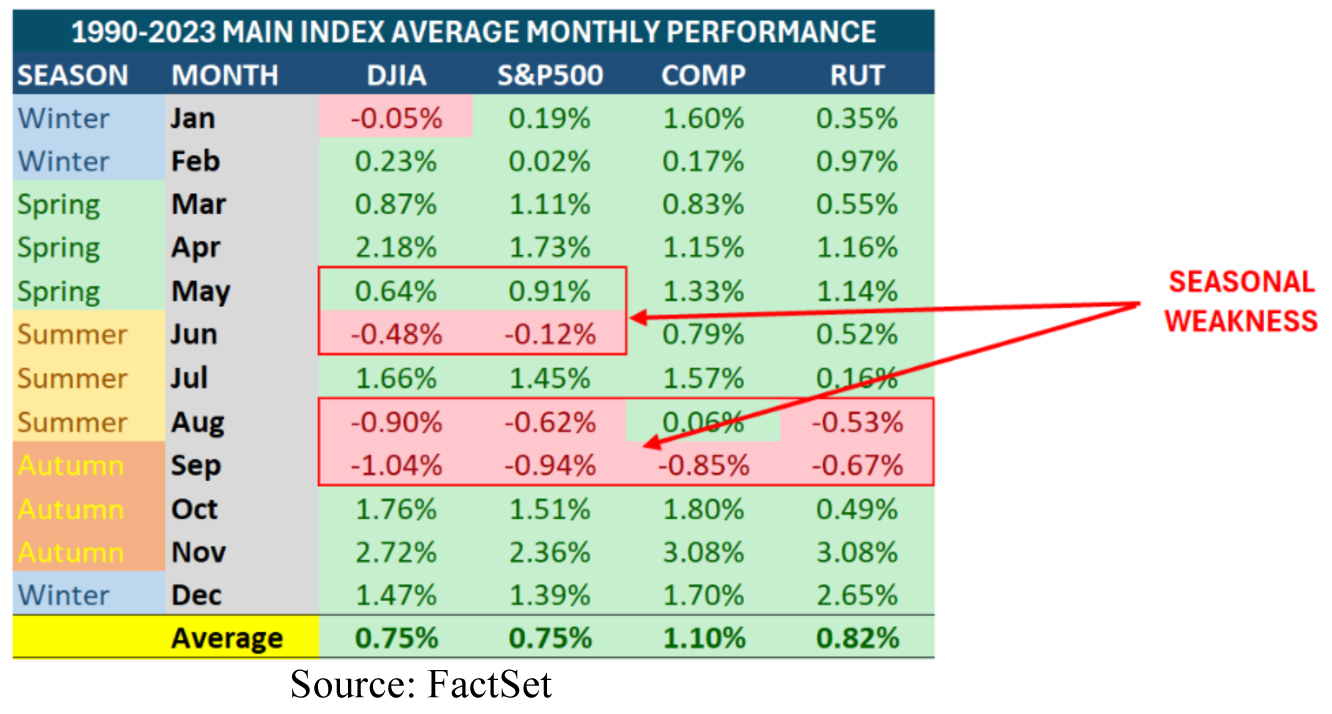
Graphs are for illustrative and discussion purposes only. Please read important disclosures at the end of this commentary.
But don’t just “sell in May and go away.” We can’t skip over June or July. According to our study, May 20th is when things should kickoff:
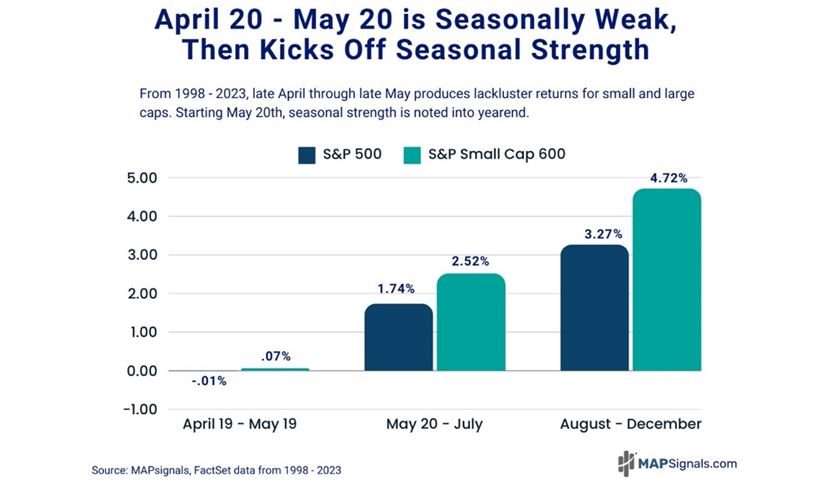
Graphs are for illustrative and discussion purposes only. Please read important disclosures at the end of this commentary.
Remember, too, that we are right in the middle of earnings season. Historically, sales and earnings “beats” are quite common about now. Here are the S&P 500 stocks broken down by historical positive surprises:
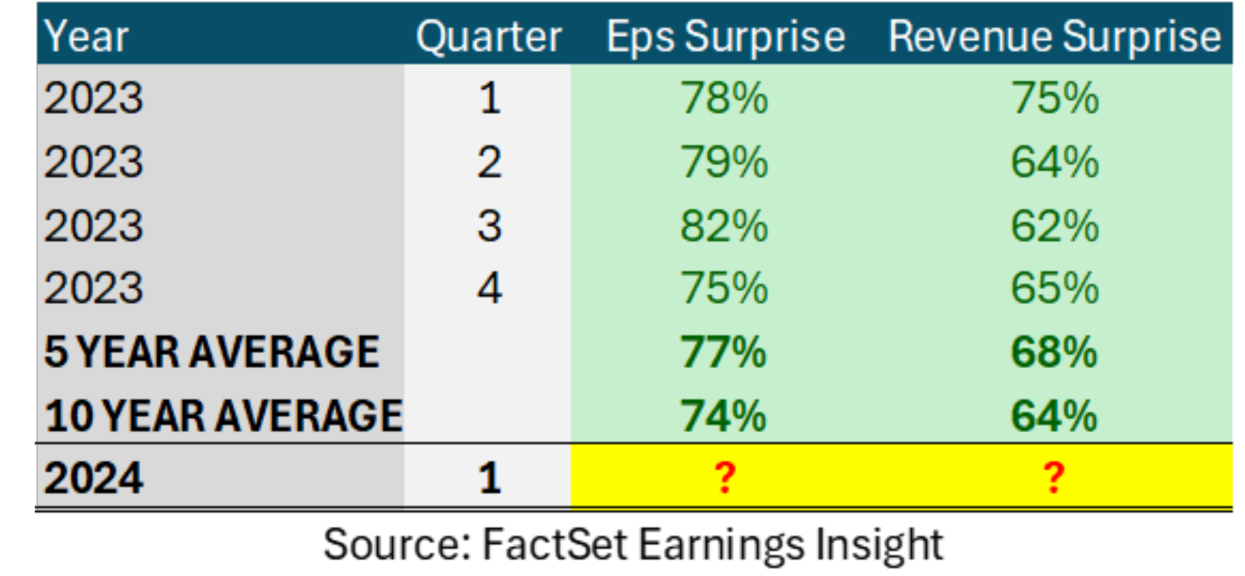
Graphs are for illustrative and discussion purposes only. Please read important disclosures at the end of this commentary.
So far, Q1 reporting is right in line. As of April 26th, with 46% of S&P 500 companies reporting results, 77% beat EPS estimates and 60% beat revenue estimates. My prediction for Q1 earnings on April 14th was that 79% of companies will beat earnings estimates and 67% will beat sales estimates. The sample size so far is almost at the half-way mark, but I’m pretty close to target on earnings surprises.
Finally, the Big Money Index (BMI) fell from overbought in February. Normally that prefaces weaker price action. Only that didn’t happen; instead, we saw continued strength. The market started softening on April 1st, but the BMI didn’t slice below its trend line until April 11th. Then it cratered.
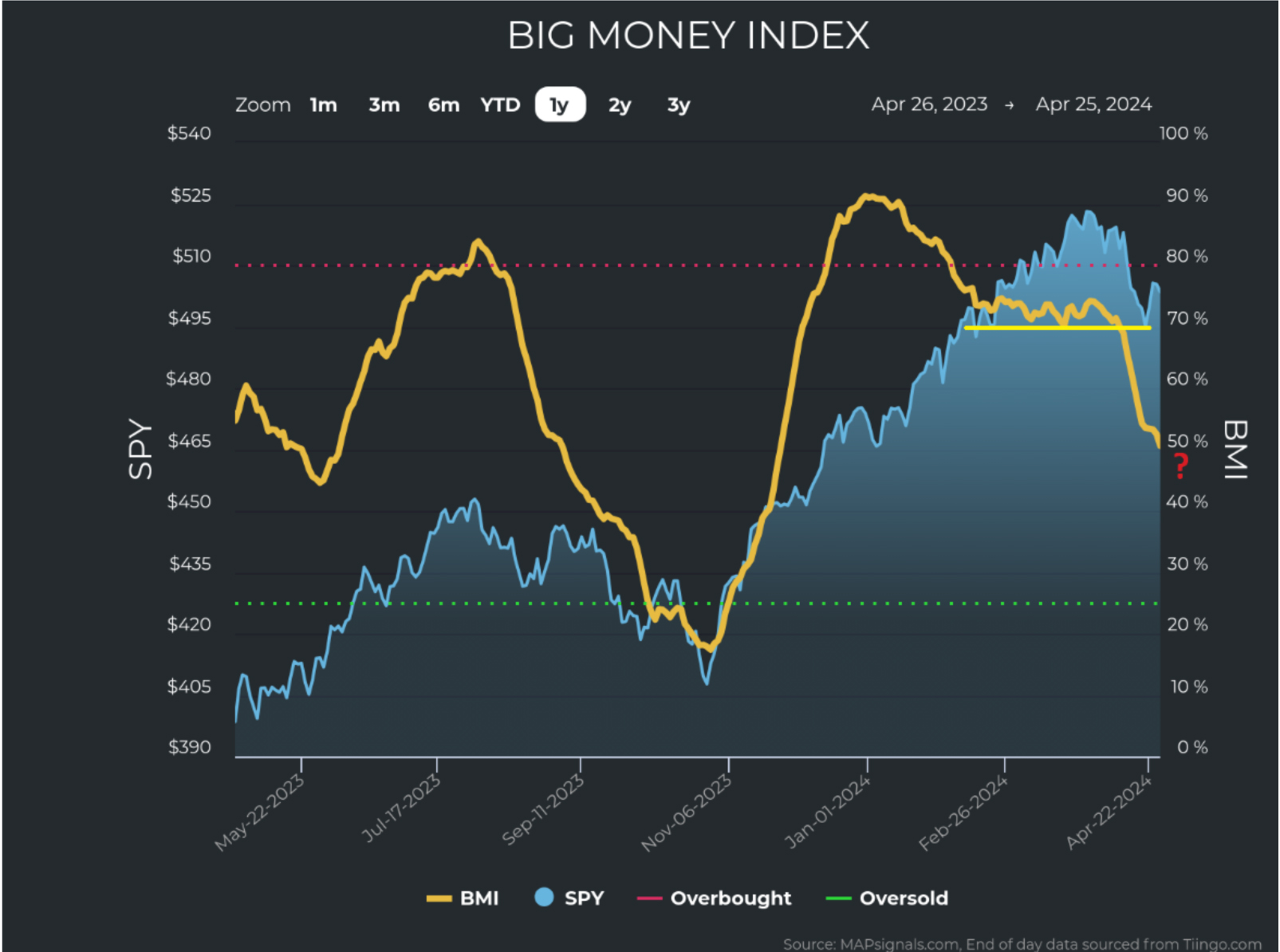
Graphs are for illustrative and discussion purposes only. Please read important disclosures at the end of this commentary.
The question is: “Where does it go from here?”
Once again, to hypothesize the future, we look to the past. The BMI hit its overbought peak of 91.3 on December 29th, 2023. Since then, it has fallen 40.7 to last Friday’s reading of 50.6. I went back to 1993 (when SPY started trading) to look at similar setups. There were a total of 303 times prior to this one when the BMI fell 40 points or more. There were six times that mirrored almost exactly this time: a fall from roughly 90 to roughly 50. The forward returns were shockingly good for long-term gains from there:
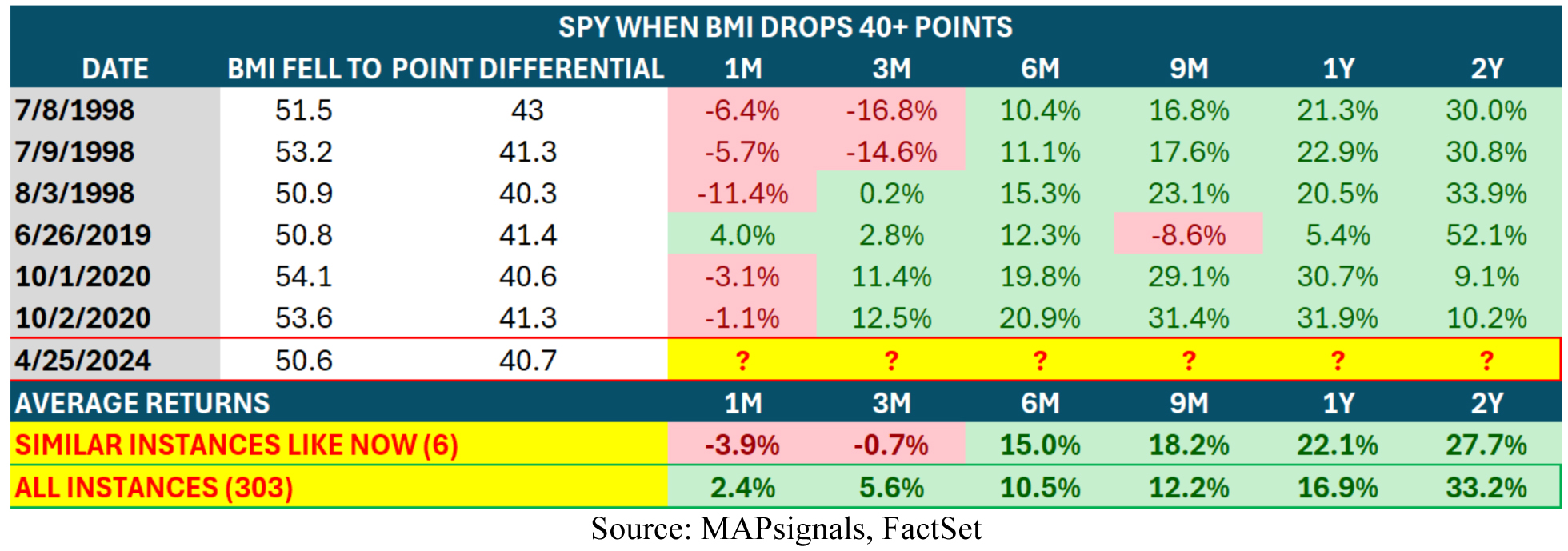
Graphs are for illustrative and discussion purposes only. Please read important disclosures at the end of this commentary.
Simply put, volatility is here, but that’s normal. History says we will not only be fine, we will likely do great. I like that narrative. Now is a great time to identify great stocks going on potential sale. Instead of worrying about the future, let’s embrace it. It was Horace who said: “Seize the day” (“Carpe Diem!”)
All content above represents the opinion of Jason Bodner of Navellier & Associates, Inc.
Also In This Issue
A Look Ahead by Louis Navellier
The Perils of Owning the Wrong Tech Stocks
Income Mail by Bryan Perry
Three Percent Inflation Looks Like “The New Normal”
Growth Mail by Gary Alexander
Slower GDP Growth Surprised Analysts (But Not Us)
Global Mail by Ivan Martchev
The Case of the Disappearing Rate Cuts
Sector Spotlight by Jason Bodner
Selling is a Bull Market’s “Pressure Release Valve”
View Full Archive
Read Past Issues Here

Jason Bodner
MARKETMAIL EDITOR FOR SECTOR SPOTLIGHT
Jason Bodner writes Sector Spotlight in the weekly Marketmail publication and has authored several white papers for the company. He is also Co-Founder of Macro Analytics for Professionals which produces proprietary equity accumulation/distribution research for its clients. Previously, Mr. Bodner served as Director of European Equity Derivatives for Cantor Fitzgerald Europe in London, then moved to the role of Head of Equity Derivatives North America for the same company in New York. He also served as S.V.P. Equity Derivatives for Jefferies, LLC. He received a B.S. in business administration in 1996, with honors, from Skidmore College as a member of the Periclean Honors Society. All content of “Sector Spotlight” represents the opinion of Jason Bodner
Important Disclosures:
Jason Bodner is a co-founder and co-owner of Mapsignals. Mr. Bodner is an independent contractor who is occasionally hired by Navellier & Associates to write an article and or provide opinions for possible use in articles that appear in Navellier & Associates weekly Market Mail. Mr. Bodner is not employed or affiliated with Louis Navellier, Navellier & Associates, Inc., or any other Navellier owned entity. The opinions and statements made here are those of Mr. Bodner and not necessarily those of any other persons or entities. This is not an endorsement, or solicitation or testimonial or investment advice regarding the BMI Index or any statements or recommendations or analysis in the article or the BMI Index or Mapsignals or its products or strategies.
Although information in these reports has been obtained from and is based upon sources that Navellier believes to be reliable, Navellier does not guarantee its accuracy and it may be incomplete or condensed. All opinions and estimates constitute Navellier’s judgment as of the date the report was created and are subject to change without notice. These reports are for informational purposes only and are not a solicitation for the purchase or sale of a security. Any decision to purchase securities mentioned in these reports must take into account existing public information on such securities or any registered prospectus.To the extent permitted by law, neither Navellier & Associates, Inc., nor any of its affiliates, agents, or service providers assumes any liability or responsibility nor owes any duty of care for any consequences of any person acting or refraining to act in reliance on the information contained in this communication or for any decision based on it.
Past performance is no indication of future results. Investment in securities involves significant risk and has the potential for partial or complete loss of funds invested. It should not be assumed that any securities recommendations made by Navellier. in the future will be profitable or equal the performance of securities made in this report. Dividend payments are not guaranteed. The amount of a dividend payment, if any, can vary over time and issuers may reduce dividends paid on securities in the event of a recession or adverse event affecting a specific industry or issuer.
None of the stock information, data, and company information presented herein constitutes a recommendation by Navellier or a solicitation to buy or sell any securities. Any specific securities identified and described do not represent all of the securities purchased, sold, or recommended for advisory clients. The holdings identified do not represent all of the securities purchased, sold, or recommended for advisory clients and the reader should not assume that investments in the securities identified and discussed were or will be profitable.
Information presented is general information that does not take into account your individual circumstances, financial situation, or needs, nor does it present a personalized recommendation to you. Individual stocks presented may not be suitable for every investor. Investment in securities involves significant risk and has the potential for partial or complete loss of funds invested. Investment in fixed income securities has the potential for the investment return and principal value of an investment to fluctuate so that an investor’s holdings, when redeemed, may be worth less than their original cost.
One cannot invest directly in an index. Index is unmanaged and index performance does not reflect deduction of fees, expenses, or taxes. Presentation of Index data does not reflect a belief by Navellier that any stock index constitutes an investment alternative to any Navellier equity strategy or is necessarily comparable to such strategies. Among the most important differences between the Indices and Navellier strategies are that the Navellier equity strategies may (1) incur material management fees, (2) concentrate its investments in relatively few stocks, industries, or sectors, (3) have significantly greater trading activity and related costs, and (4) be significantly more or less volatile than the Indices.
ETF Risk: We may invest in exchange traded funds (“ETFs”) and some of our investment strategies are generally fully invested in ETFs. Like traditional mutual funds, ETFs charge asset-based fees, but they generally do not charge initial sales charges or redemption fees and investors typically pay only customary brokerage fees to buy and sell ETF shares. The fees and costs charged by ETFs held in client accounts will not be deducted from the compensation the client pays Navellier. ETF prices can fluctuate up or down, and a client account could lose money investing in an ETF if the prices of the securities owned by the ETF go down. ETFs are subject to additional risks:
- ETF shares may trade above or below their net asset value;
- An active trading market for an ETF’s shares may not develop or be maintained;
- The value of an ETF may be more volatile than the underlying portfolio of securities the ETF is designed to track;
- The cost of owning shares of the ETF may exceed those a client would incur by directly investing in the underlying securities; and
- Trading of an ETF’s shares may be halted if the listing exchange’s officials deem it appropriate, the shares are delisted from the exchange, or the activation of market-wide “circuit breakers” (which are tied to large decreases in stock prices) halts stock trading generally.
Grader Disclosures: Investment in equity strategies involves substantial risk and has the potential for partial or complete loss of funds invested. The sample portfolio and any accompanying charts are for informational purposes only and are not to be construed as a solicitation to buy or sell any financial instrument and should not be relied upon as the sole factor in an investment making decision. As a matter of normal and important disclosures to you, as a potential investor, please consider the following: The performance presented is not based on any actual securities trading, portfolio, or accounts, and the reported performance of the A, B, C, D, and F portfolios (collectively the “model portfolios”) should be considered mere “paper” or pro forma performance results based on Navellier’s research.
Investors evaluating any of Navellier & Associates, Inc.’s, (or its affiliates’) Investment Products must not use any information presented here, including the performance figures of the model portfolios, in their evaluation of any Navellier Investment Products. Navellier Investment Products include the firm’s mutual funds and managed accounts. The model portfolios, charts, and other information presented do not represent actual funded trades and are not actual funded portfolios. There are material differences between Navellier Investment Products’ portfolios and the model portfolios, research, and performance figures presented here. The model portfolios and the research results (1) may contain stocks or ETFs that are illiquid and difficult to trade; (2) may contain stock or ETF holdings materially different from actual funded Navellier Investment Product portfolios; (3) include the reinvestment of all dividends and other earnings, estimated trading costs, commissions, or management fees; and, (4) may not reflect prices obtained in an actual funded Navellier Investment Product portfolio. For these and other reasons, the reported performances of model portfolios do not reflect the performance results of Navellier’s actually funded and traded Investment Products. In most cases, Navellier’s Investment Products have materially lower performance results than the performances of the model portfolios presented.
This report contains statements that are, or may be considered to be, forward-looking statements. All statements that are not historical facts, including statements about our beliefs or expectations, are “forward-looking statements” within the meaning of The U.S. Private Securities Litigation Reform Act of 1995. These statements may be identified by such forward-looking terminology as “expect,” “estimate,” “plan,” “intend,” “believe,” “anticipate,” “may,” “will,” “should,” “could,” “continue,” “project,” or similar statements or variations of such terms. Our forward-looking statements are based on a series of expectations, assumptions, and projections, are not guarantees of future results or performance, and involve substantial risks and uncertainty as described in Form ADV Part 2A of our filing with the Securities and Exchange Commission (SEC), which is available at www.adviserinfo.sec.gov or by requesting a copy by emailing info@navellier.com. All of our forward-looking statements are as of the date of this report only. We can give no assurance that such expectations or forward-looking statements will prove to be correct. Actual results may differ materially. You are urged to carefully consider all such factors.
FEDERAL TAX ADVICE DISCLAIMER: As required by U.S. Treasury Regulations, you are informed that, to the extent this presentation includes any federal tax advice, the presentation is not written by Navellier to be used, and cannot be used, for the purpose of avoiding federal tax penalties. Navellier does not advise on any income tax requirements or issues. Use of any information presented by Navellier is for general information only and does not represent tax advice either express or implied. You are encouraged to seek professional tax advice for income tax questions and assistance.
IMPORTANT NEWSLETTER DISCLOSURE:The hypothetical performance results for investment newsletters that are authored or edited by Louis Navellier, including Louis Navellier’s Growth Investor, Louis Navellier’s Breakthrough Stocks, Louis Navellier’s Accelerated Profits, and Louis Navellier’s Platinum Club, are not based on any actual securities trading, portfolio, or accounts, and the newsletters’ reported hypothetical performances should be considered mere “paper” or proforma hypothetical performance results and are not actual performance of real world trades. Navellier & Associates, Inc. does not have any relation to or affiliation with the owner of these newsletters. There are material differences between Navellier Investment Products’ portfolios and the InvestorPlace Media, LLC newsletter portfolios authored by Louis Navellier. The InvestorPlace Media, LLC newsletters contain hypothetical performance that do not include transaction costs, advisory fees, or other fees a client might incur if actual investments and trades were being made by an investor. As a result, newsletter performance should not be used to evaluate Navellier Investment services which are separate and different from the newsletters. The owner of the newsletters is InvestorPlace Media, LLC and any questions concerning the newsletters, including any newsletter advertising or hypothetical Newsletter performance claims, (which are calculated solely by Investor Place Media and not Navellier) should be referred to InvestorPlace Media, LLC at (800) 718-8289.
Please note that Navellier & Associates and the Navellier Private Client Group are managed completely independent of the newsletters owned and published by InvestorPlace Media, LLC and written and edited by Louis Navellier, and investment performance of the newsletters should in no way be considered indicative of potential future investment performance for any Navellier & Associates separately managed account portfolio. Potential investors should consult with their financial advisor before investing in any Navellier Investment Product.
Navellier claims compliance with Global Investment Performance Standards (GIPS). To receive a complete list and descriptions of Navellier’s composites and/or a presentation that adheres to the GIPS standards, please contact Navellier or click here. It should not be assumed that any securities recommendations made by Navellier & Associates, Inc. in the future will be profitable or equal the performance of securities made in this report.
FactSet Disclosure: Navellier does not independently calculate the statistical information included in the attached report. The calculation and the information are provided by FactSet, a company not related to Navellier. Although information contained in the report has been obtained from FactSet and is based on sources Navellier believes to be reliable, Navellier does not guarantee its accuracy, and it may be incomplete or condensed. The report and the related FactSet sourced information are provided on an “as is” basis. The user assumes the entire risk of any use made of this information. Investors should consider the report as only a single factor in making their investment decision. The report is for informational purposes only and is not intended as an offer or solicitation for the purchase or sale of a security. FactSet sourced information is the exclusive property of FactSet. Without prior written permission of FactSet, this information may not be reproduced, disseminated or used to create any financial products. All indices are unmanaged and performance of the indices include reinvestment of dividends and interest income, unless otherwise noted, are not illustrative of any particular investment and an investment cannot be made in any index. Past performance is no guarantee of future results.
